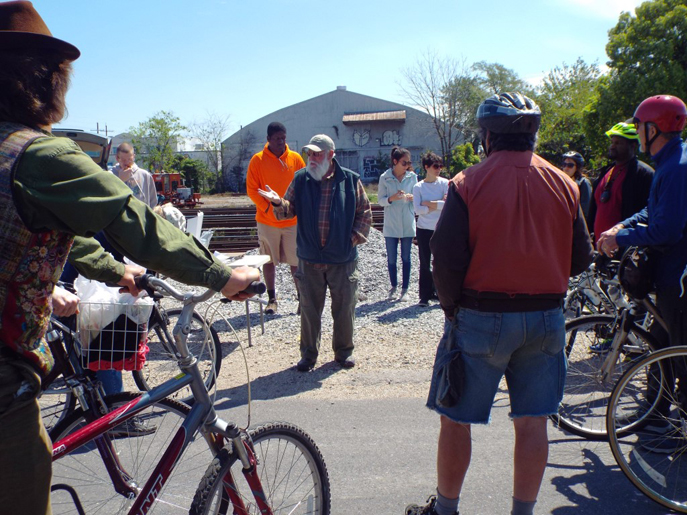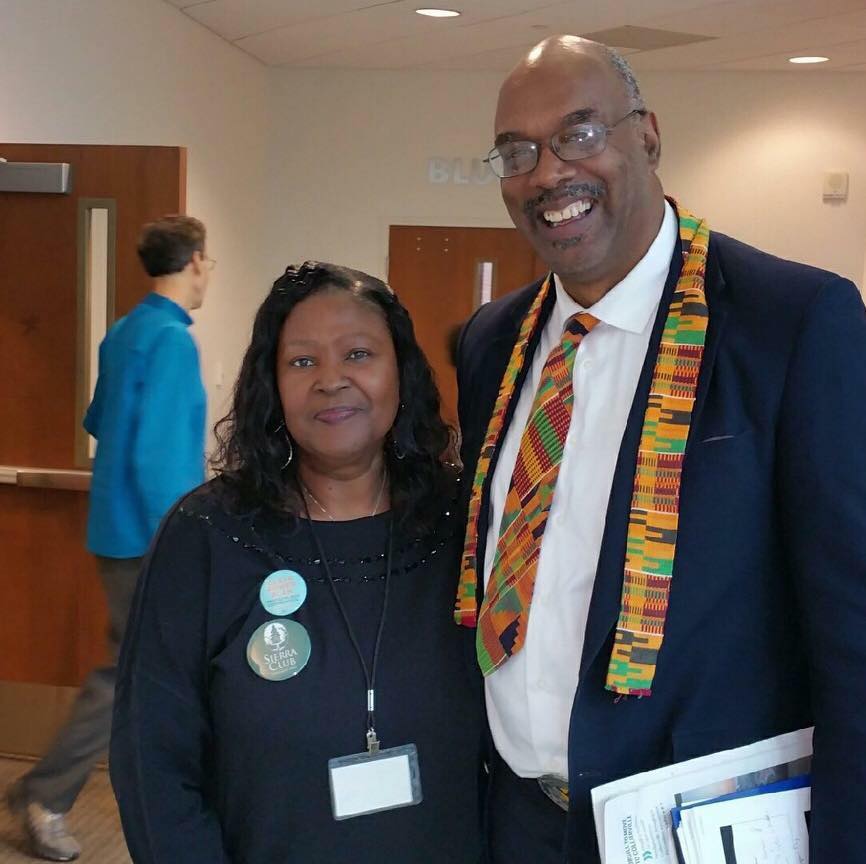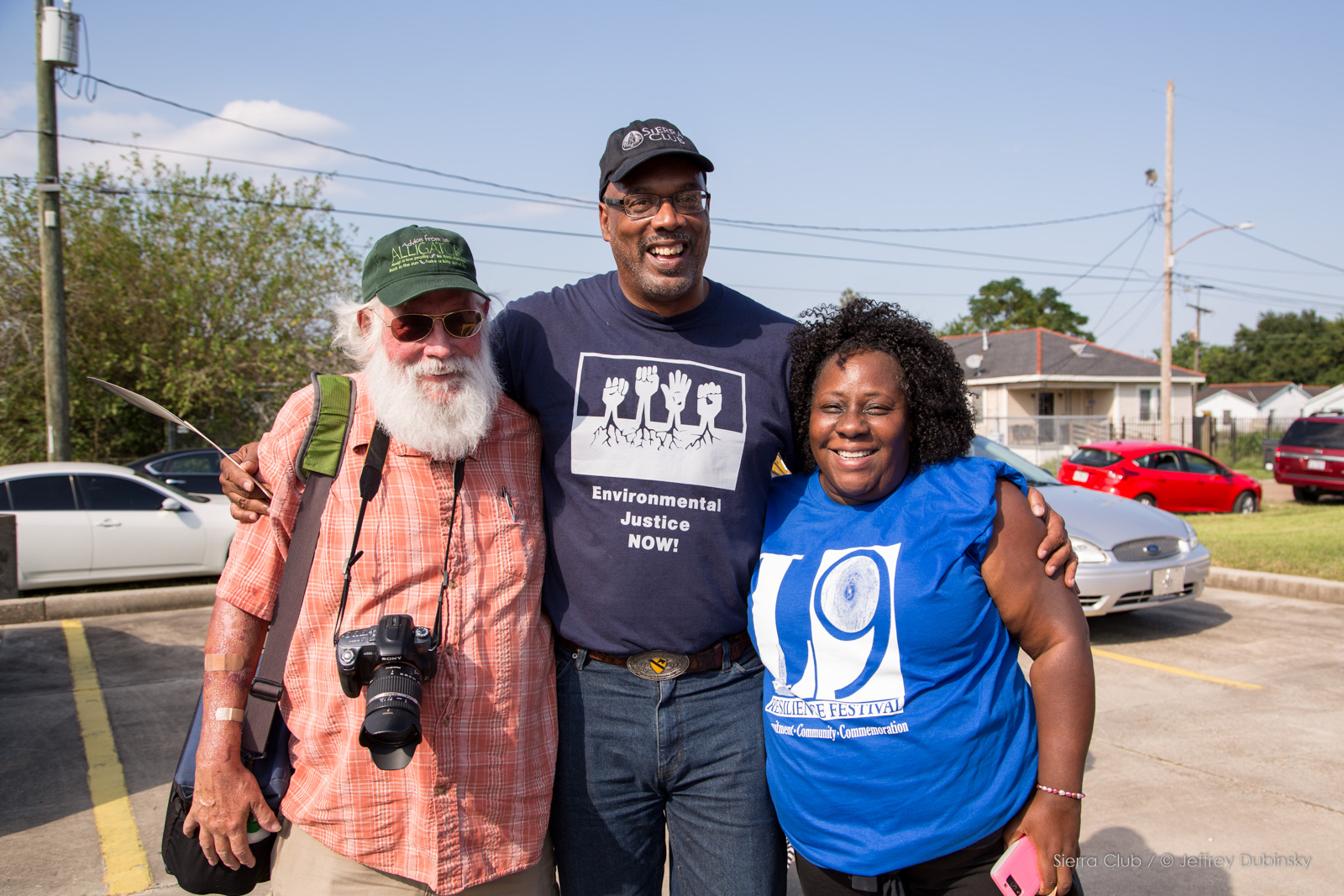
Sierra Club environmental justice organizer Darryl Malek-Wiley speaking at the Connect the 9 bike ride in New Orleans.
Memphis and New Orleans may be separated by about 400 miles and a handful of small towns, but the destinations share two qualities: their location along the Mississippi River and their status as major hot spots for environmental activism and justice.
In 2014 the Tennessee Valley Authority’s (TVA) board of directors voted to retire the coal-fired Allen Fossil Plant in Memphis and retro fit their facility to accommodate natural gas in its place. Rita Harris, a Sierra Club environmental justice organizer based in Memphis saw this as a success, and a big step towards reducing reliance on coal. More important, she saw it as a way to promote healthier living in a city that is not always exemplary in terms of its citizens’ health and wellbeing. “We’re a community that is made up of a lot of low income, minority groups,” she explains. “These are the people that suffer the most when large companies need a place to dump their waste.” With a change from coal to natural gas, the facility was able to stop using roughly 7,200 tons of coal daily, improving air quality significantly.
Harris has devoted her full attention to environmental justice since 1991 when she first began learning about pollutants and their adverse effects on human health. She was most alarmed when she learned that women, children, minorities, the elderly, the mentally ill, and poor people disproportionately bear the negative consequences. “I felt the majority of community residents had no idea about the factory down the street or around the corner, nor did they have a clue about what was coming out of the smokestacks,” Harris says. This concern has driven her efforts to bring awareness to neighborhoods and communities as she mentors individuals to become active in challenging permits and protecting themselves.
Harris has focused on many neighborhood projects over the years and most recently is working with the Southern Alliance for Clean Energy and the Memphis Branch NAACP. In honor of Earth Day 2016, the Just Energy Memphis coalition hosted a luncheon at the Memphis BioWorks Foundation to discuss the unfair energy burden in the local area. The timing of these conversations became alarmingly pertinent as they closely followed Memphis being identified as one of the top ten U.S. cities with the highest energy burdens by the American Council for an Energy-Efficient Economy. For Memphians, this means that an average of just over 6 percent of their income goes to energy bills. This more than doubles for low-income families, who shell out nearly 13 percent of their income on utility bills. The Just Energy Memphis coalition works with utility companies to push TVA to allocate more funds for energy efficiency and particularly toward weatherizing old homes.
Currently Harris is working to promote a new campaign, “Share the Pennies.” The program, sponsored by MLGW (Memphis Light, Gas and Water) allows individuals to opt in to rounding up their household monthly utility bill to the next whole dollar. The difference is donated to Project CARE. The Project CARE Fund is an energy-efficiency program that aids the elderly and disabled with home weatherization and repairs. It is estimated that within a year, 30,000 people will benefit by receiving up to $1,500 from the CARE Fund.

Rita Harris with Sierra Club President Aaron Mair.
On January 19 Harris was a key organizer of a Sierra Club-hosted rally in downtown Memphis in front of the Federal Building calling on Senators Alexander and Corker to vote against former Oklahoma Attorney General, Scott Pruitt for EPA Administrator. Pruitt has conspired with the fossil fuel industry to attack EPA regulations. He describes himself as a “leading advocate against the EPA’s activist agenda.” Harris sees the urgency of barring Pruitt from heading up the EPA, recognizing the severe consequences this would have on both the national and local level.
Harris is proud that Memphis is the only place where Sierra Club annually hosts a grassroots environmental justice conference. In fact, 2017 will mark the 14th year that the event has taken place since its grassroots beginning. Each year, about 250 people sign up and attend the free event which Harris calls, “a day of learning, where people are exposed to experts on a wide range of topics.”
A regular focus of this conference are the issues of air and water pollution and the people whose day-to-day lives are negatively affected. Harris explains that Memphis has always been an industrial hub with many industrial plants legally permitted to discharge pollution into our air and rivers and streams.Some local residents regularly fish in the Mississippi River which is contaminated by pollution from a variety of sources. "The EPA claims that eating fish from this river is ok if consumption does not exceed recommended monthly limits," Harris explains, "but the EPA isn't taking into account the fact that many of these local fishermen are unaware of the warnings and recommended eating limits." She has been working closely with local churches to distribute easy-to-understand brochures about the dangers of fishing in local waters, including the Mississippi River.
In addition to being an information hub, Harris and the Club’s Chickasaw Group organizers see themselves as watchdogs and community protectors. In 2005, they worked on one of their biggest successful campaigns; stopping a low-level nuclear waste incinerator from locating near downtown Memphis and several African American neighborhoods. The State of Tennessee already allows low-level waste to be buried along with household trash, claiming that a small amount of residual radiation won't hurt." In response, Harris and her team kept repeating a now-familiar mantra: "There is no safe dose." After ten months the City Council ruled that the incinerator would not get the necessary permit and would not operate in Memphis. Most recently, they have been trying to get officials to revisit the practice of burying low-level nuclear waste in the two local landfills which could threaten the drinking water aquifer.
Above all, Harris sees the importance of including a wide range of voices and opinions in discussions and decision-making about environmental issues and initiatives. For Harris, environmental justice work is not about seeking media attention and coverage, but rather seeking a wide array of community voices and amplifying them. In Harris’ words, “By listening to one another we will learn the real issues, and by acting on those issues and not just the ones that we perceive to be important, we are actually making a difference.”

Rita Harris
In “The Big Easy,” Darryl Malek-Wiley, a Sierra Club environmental justice organizer who works closely with the New Orleans Group of the Delta Chapter, has been a member of the Club since 1972. Since becoming involved in environmental justice work in the 1980’s, Malek-Wiley’s focus has been on facilitating communication between distinct and diverse community groups coalitions, and more broadly, amongst neighboring states.
Malek-Wiley is drawn to understanding the core reasons behind environmental injustice and the realities that low-income communities of color are facing. One of his first projects in the late 80s was working closely with individuals and communities living in government-subsidized housing along the Mississippi River. After learning that people were getting sick, Malek-Wiley discovered that a nearby herbicide plant was dumping chemicals into the water that flows by the housing complexes. He set to work organizing people and informing them of their housing rights. The 85-mile stretch Mississippi River from Baton Rouge to New Orleans where Malek-Wiley worked was formerly referred to as the "petrochemical corridor" but after numerous reports of cancer cases popping up on both sides of the river the entire area became known as cancer alley.
Along with the Delta Chapter, Malek-Wiley was a key leader in forming The Regional Conservation Committee (RCC) which includes representatives from Florida, Louisiana, Mississippi, Alabama, Texas, and Tennessee. At regular meetings, environmental justice advocates discuss issues and ways to combat them as a team. “It’s a space for volunteers to really see how environmental justice issues cut across state lines,” Malek-Wiley said. “Talking about these issues on a broader scale is often more beneficial.”
This idea of cooperation and collaboration has allowed Malek-Wiley and other local Club activists to have a positive impact after the devastations of Hurricane Katrina in 2005. Since the storm, Wiley has concentrated on the Lower 9th Ward, the most heavily affected neighborhood in New Orleans. By engaging individuals in conversation and reflection on what “rebuilding sustainably” can and should look like, Malek-Wiley is raising awareness all over the city.
“Most people think of solar panels and renewable energy as luxuries for white people in comfy suburbs,” Wiley says, “The Lower 9th Ward’s demographics are 95 percent African American who are living below the poverty line.” Malek-Wiley’s message to the community is that eco can and should be for everyone. He believes that slowly, people are getting the big-picture idea that by investing in solar now, it will result in more money in their pockets later.
After Hurricane Katrina devastated the city’s public transportation system, the Regional Transit Authority was tasked with a massive reconstruction project. While the bus service is still operating at 35 percent of its pre-storm capacity, the entire fleet runs on biodiesel or a biodiesel/electric combination. Wiley has played a large role in working with the transit system to increase its accessibility and reliability.
With transportation in mind, Malek-Wiley worked with students at the University of New Orleans to conduct a study examining how residents of the Lower 9th Ward were getting into the city center each day. They realized that most people were biking or walking and that of the three bridges connecting the Ward to the rest city, only one, the St. Claude Bridge, was “sort-of feasible” for cyclists and pedestrians to cross. Using this study as support, Malek-Wiley is now working with the Regional Planning Commission to campaign for an increase in biking and walking space on the bridge.
After Katrina, the city’s water plan also needed to be revised. All water that is used in New Orleans must then be pumped back out of the city—a process that has proved to be a challenge to carry out sustainably. As part of the Delta City’s Living with Water Project and vision, Malek-Wiley is asking, “how can we live with water in the coming decades?” In 2010, the Louisiana Office of Community Development’s Disaster Recovery Unit funded Greater New Orleans, Inc. This team’s goal was to develop the Greater New Orleans Urban Water Plan for Orleans, Jefferson, and St. Bernard Parishes with the use of disaster funds from the Department of Housing and Urban Development. By working closely with this team, Malek-Wiley is ensuring that storm water and groundwater are seen as valuable resources and that the people who will benefit from the plan are being taken into consideration every step of the way.
A recent threat to the community includes Entergy’s proposal to build a natural gas power plant on the east side of the city. Sierrans have joined other local residents in opposing the plan asserting that it will pollute neighborhoods and shackle the city to electricity generated by fossil fuels for the foreseeable future. Malek-Wiley is also concerned about the proposed South Louisiana Pipeline which would connect to the Dakota Access Pipeline in North Dakota. The 162-mile South Louisiana pipeline would be built by Dakota Access LLC, a subsidiary of Energy Transfer Partners, and would cut through 11 Louisiana parishes and the Atchafalaya Basin, the nation’s largest wetland and swamp. Malek-Wiley will be attending hearings and press conferences in the weeks to come to both increase awareness, and share the publics’ views with key shareholders.
In 2015, the Club’s Orleans Group hosted Lieutenant General Russel Honore, who spoke about his vision to create an interconnected and human-focused environmental movement in Louisiana. The “Ragin’ Cajun” is famous for his service during Hurricane Katrina and for his efforts to protect the environment as the city undergoes its reconstruction process after the storm. As an emerging leader, the now retired Lieutenant is heading up the “Louisiana Green Army,” a task force comprised of civic, community, and environmental groups, including the Sierra Club. The self-proclaimed “pollution fighters” have set to work addressing coastal erosion, saltwater intrusion in the Baton Rouge Aquifer, sinkholes in Bayou Corne, fracking in St. Tammany Parish, and drilling concerns in Lake Peigneur natural gas storage caverns. Malek-Wiley, who sits on the Green Army’s steering committee sees hope in the city’s willingness to collaborate and get behind these pressing issues.
After the 2016 presidential election, Malek-Wiley is concerned that it may be hard to get the same funding from the federal government to deal with the massive issues that still-recovering New Orleans is facing. He says that his goal as an environmental justice leader is to promote quality jobs, education, accessible green transportation, and an overall healthy environment. But his main focus is on people. “Sure, we want to protect the forests of Alaska or the wildlife in Northern California,” he says, “but we also need to think about the people drinking the water in Flint, Michigan, or the native lands that will be destroyed by a pipeline in Standing Rock, or the women left behind in the Lower 9th Ward.”
John Muir famously said, “When we try to pick out anything by itself we find it hitched to everything else in the universe.” Malek-Wiley feels that these words perfectly describe his work as an environmental justice activist. When one community challenge is chosen as a point of focus it leads to ten others that are inherently connected…and so on.

Malek-Wiley with Mair and Lower 9 Resilience Festival executive director Kim Ford.
As our environment and humanity itself are under increasing threat from human-caused climate change, it is comforting to know that people like Darryl Malek-Wiley in New Orleans and Rita Harris in Memphis are relentlessly working as stewards of the land and protectors of its people.